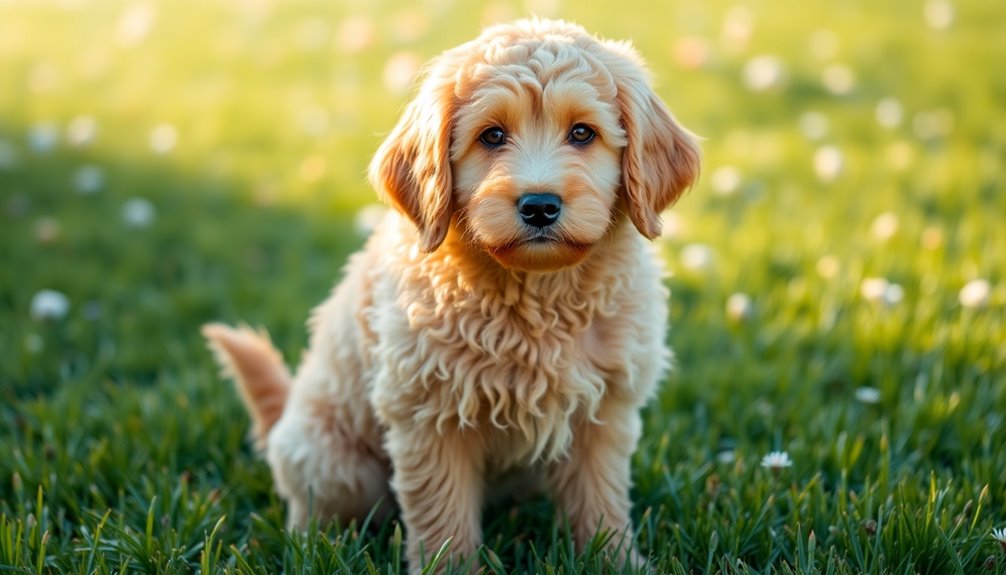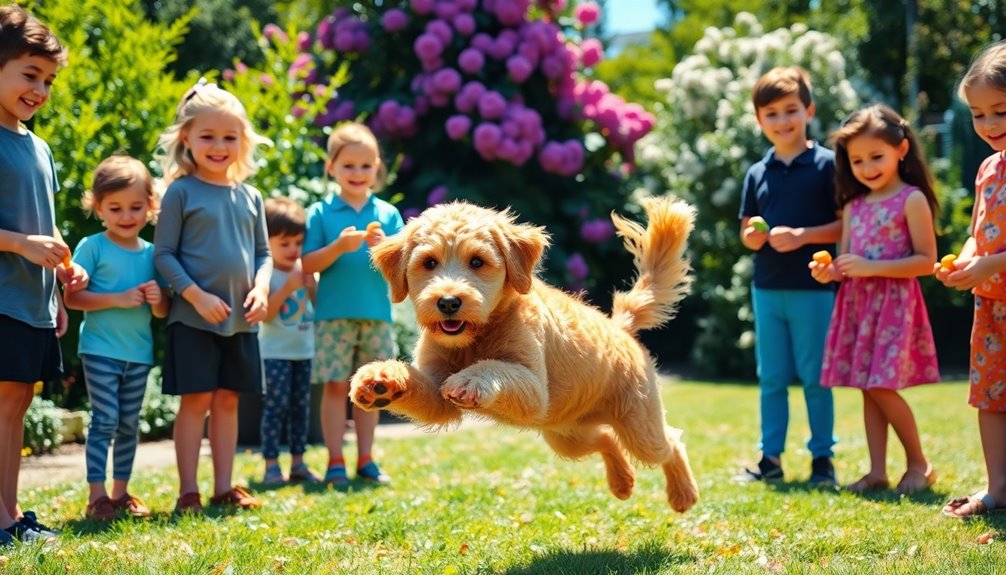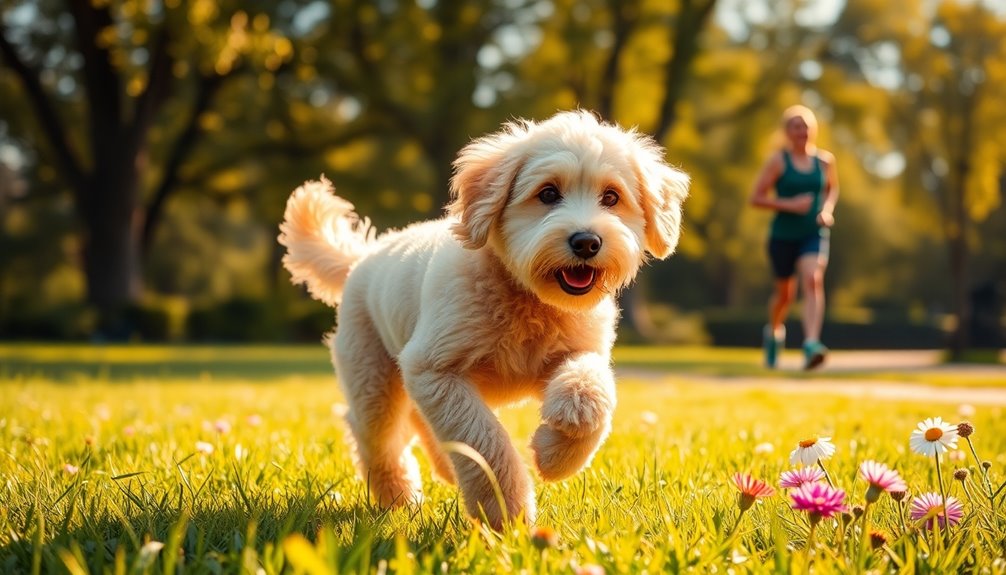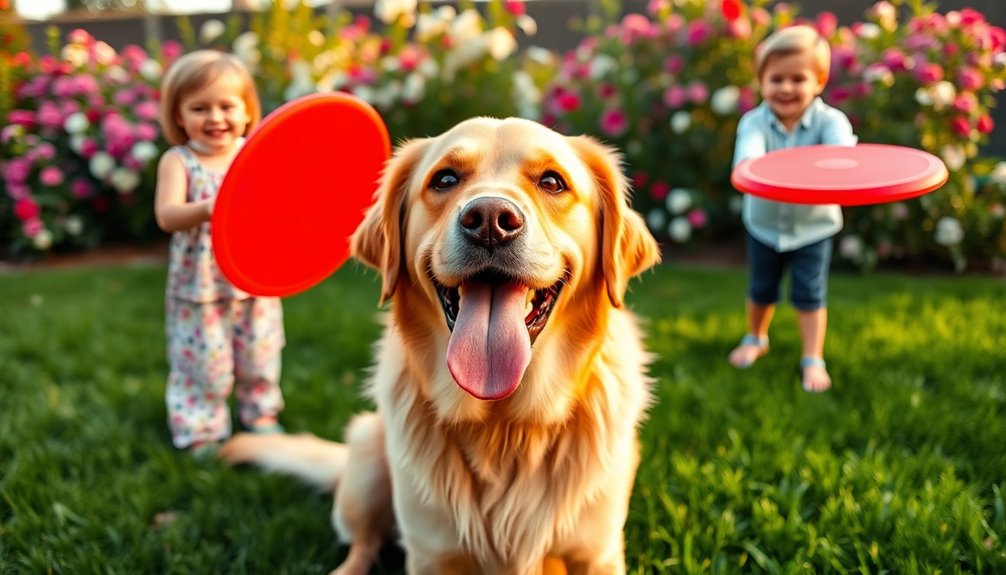Labradoodles are the perfect blend of loyalty and intelligence. Originating in Australia, they were bred to be hypoallergenic guide dogs. Their playful yet gentle nature makes them excellent companions, thriving with families and other pets. With an array of coat types and sizes, they cater to diverse lifestyles. Regular exercise keeps them happy and healthy, while early training enhances their responsiveness. Although they're not entirely hypoallergenic, their unique coats help minimize allergens. These wonderful dogs truly shine in therapy roles. If you're curious about their care and traits, there's so much more to discover!
Key Takeaways
- Labradoodles combine the loyalty of Labradors with the intelligence of Poodles, making them highly trainable and affectionate companions.
- Their hypoallergenic coats reduce allergens, making them suitable for allergy sufferers while requiring regular grooming to maintain coat health.
- Known for their playful and gentle temperament, Labradoodles thrive in family environments and adapt well to various living situations.
- They require 60-90 minutes of daily exercise, which helps prevent hyperactivity and supports their mental stimulation and overall well-being.
- With a lifespan of 12 to 15 years, Labradoodles benefit from hybrid vigor, often leading to fewer health issues compared to purebred dogs.
Introduction

Labradoodles are often celebrated for their unique combination of loyalty and intelligence, making them a beloved choice for families and individuals alike.
These dogs come in three distinct sizes: miniature, medium, and standard, allowing you to find the perfect fit for your lifestyle. Their coats can be soft and wavy, curly, or straighter, offering options for families concerned about allergies. Labradoodles also have hypoallergenic qualities, which makes them suitable for many allergy sufferers.
With a wide variety of colors, including cream, apricot, and chocolate, Labradoodles also stand out in appearance. Their athletic build, floppy ears, and warm, round eyes give them an endearing presence.
Labradoodles are friendly and sociable, thriving on interaction with people and other pets. They form strong bonds with family members, including children, due to their gentle and patient nature.
This social dog loves physical activities like fetching and hiking, requiring regular exercise to stay happy and healthy.
Their high trainability means they learn quickly and respond well to positive reinforcement, making early training essential.
With proper care, you'll have a loving, adaptable companion ready to join in on family adventures.
History and Origin

The Labradoodle originated in Australia during the 1980s when a blind woman in Hawaii requested a hypoallergenic guide dog.
Wally Conron, a breeding specialist, took on the challenge, aiming to combine the intelligence of Labradors with the low-shedding coat of Poodles.
This innovative breeding initiative was a response to the needs of allergy sufferers seeking assistance and companionship. The breed's friendly disposition and intelligence have since made it a favorite among families and individuals alike.
Where and when the breed originated
In Australia during the late 1980s, a new breed emerged thanks to Wally Conron, who worked with the Royal Guide Dogs Association of Australia. The initiative began in 1989 when Conron received a request for a guide dog suitable for a visually impaired individual.
To meet this need, he crossbred a Labrador Retriever with a Poodle, aiming for specific traits like intelligence, a hypoallergenic coat, and trainability.
The first litter of Labradoodles was a success, laying the foundation for further breeding efforts. While the term "Labradoodle" was first introduced in 1955 by Donald Campbell, it was in 1989 that Conron officially brought the breed to the Royal Guide Dog Association. This initial breeding success marked the beginning of a rapid rise in popularity, with Labradoodles quickly becoming sought after not only for service roles but also as family pets.
As the breed gained traction, it led to the creation of multi-generational Australian Labradoodles. Their friendly and adaptable nature helped them spread globally, becoming cherished companions and versatile assistance dogs, all thanks to Wally Conron's vision and dedication.
Assistance for Allergy Sufferers
Recognizing the need for a hypoallergenic guide dog, Wally Conron embarked on a groundbreaking breeding project in the late 1980s. This initiative was sparked by a request from a blind woman in Hawaii whose husband suffered from severe allergies.
Conron first tested 33 samples of poodle hair and saliva, but all caused allergic reactions. However, crossing a Standard Poodle with a Labrador Retriever birthed the first litter of Labradoodles, and one puppy, Sultan, stood out as allergy-friendly. Sultan was trained as a guide dog, proving the concept's success. The first successful allergy-friendly dog encouraged further breeding efforts that incorporated other breeds like the Irish Water Spaniel and Cocker Spaniel. This expansion enhanced the breed's health, temperament, and allergy-friendly traits. The result? A diverse gene pool that consistently produced coats like fleece and wool, reducing dander significantly.
While Labradoodles aren't 100% hypoallergenic, their unique coats make them highly beneficial for allergy sufferers. Their intelligence and trainability also establish them as ideal service dogs and family pets.
Physical Characteristics

When you look at a Labradoodle, you'll notice they come in three sizes: Miniature, Medium, and Standard, each with a sturdy and athletic build.
Their coats can vary from wooly curls to softer fleece, making them a great option for allergy sufferers. Common coat colors include shades like chocolate, black, and cream, adding to the diversity of their appearance.
With a range of colors and textures, these dogs not only look unique but also offer a hypoallergenic solution for many families.
Size, weight, and coat details
Boasting a variety of sizes and weights, Labradoodles can fit into many lifestyles. You'll find three main size categories: Miniature, Medium, and Standard.
Miniature Labradoodles stand 14-16 inches tall and weigh between 15-25 pounds. Medium Labradoodles range from 17-20 inches in height and weigh 30-45 pounds, with females typically measuring 17-19 inches and males 18-20 inches.
Standard Labradoodles, on the other hand, grow to be 21-24 inches tall and weigh 50-65 pounds, with females at 21-23 inches and males at 22-24 inches. In addition, Medium Labradoodles are known for their versatility, making them suitable for various lifestyles.
As for growth patterns, Miniature and Medium Labradoodles reach their adult size in about 11-13 months, while Standard ones may take a bit longer, around 12.5-16 months.
When predicting weight, consider that at 2 months, a puppy's weight is about a quarter of its estimated adult weight, and by 4 months, it's roughly half.
Keep in mind that Standard Labradoodles can weigh up to 70 pounds when fully grown, so choose the size that best matches your living situation and activity level!
Curly, Hypoallergenic Coat Texture
With their dense, curly coats, Labradoodles aren't just visually striking but also known for their hypoallergenic properties. Their wool coats, tightly curled and reminiscent of their Poodle ancestors, produce fewer allergens, making them an excellent choice for allergy sufferers.
You'll appreciate that these dogs shed minimally, which significantly reduces the amount of dander released into your home. Understanding the hypoallergenic traits of Labradoodles can greatly aid prospective owners in making informed decisions regarding pet ownership.
To keep that luxurious coat looking its best, regular grooming is essential. You'll need specific tools designed for hypoallergenic breeds to prevent matting and tangling. This maintenance ensures that your Labradoodle not only looks shiny and well-kept but also retains its hypoallergenic qualities.
When compared to other coat types, such as the fleece or hair coats, the Labradoodle's wool coat stands out for its low shedding and reduced allergen production.
Fleece coats may provide some hypoallergenic benefits, but the wool coat is your best bet for allergy suitability. If you choose a Labradoodle from the F2B generation, you'll likely find even greater hypoallergenic traits, enhancing your experience with this wonderful breed.
Temperament and Personality

When you think of a Labradoodle, picture a playful yet gentle companion that fits seamlessly into any family.
Their affectionate nature makes them suitable for families, individuals, and even other pets, ensuring everyone feels included. This breed's outgoing and playful nature makes them excellent family companions, always ready to engage in fun activities.
With their friendly demeanor, they create strong bonds and bring joy to any home.
Playful yet Gentle Demeanor
The Labradoodle's playful yet gentle demeanor makes it a fantastic companion for families and individuals alike. These dogs are friendly and outgoing, loving to interact with people and other animals. You'll find they form strong bonds with their families, thriving on social engagement.
While they may not excel as guard dogs due to their amiable nature, their adaptability allows them to fit seamlessly into various social situations. Their intelligence shines through, making them easy to train and eager to learn new commands and tricks. You can engage them in obedience, agility, or even service work, and you'll notice how they thrive on mental stimulation.
Regular exercise is essential for their energetic nature; they enjoy activities like fetch, hikes, and outdoor adventures. Without proper outlets for their energy, they may become hyperactive. Inadequate exercise can contribute to behavioral issues, so it's crucial to keep them active and engaged.
Affectionate and loving, Labradoodles thrive when included in family activities, whether it's playtime or cuddling on the couch. This adaptability means they can fit into active households or relax indoors, but be mindful of their need for companionship, as they can develop separation anxiety when left alone for extended periods.
Suitability for families, individuals, or other pets
Loyalty and affection define the Labradoodle's temperament, making them an ideal choice for families, individuals, and other pets. They're friendly and patient, thriving in family settings where they bond with every member. Their adaptable nature allows them to fit into various living environments, as long as you meet their exercise needs. Supervision is key, especially around young children, to ensure safe interactions.
For those with other dogs, Labradoodles are social and friendly, easily forming friendships when introduced gradually. Supervised playtime and positive reinforcement foster strong bonds between them and other dogs. Additionally, their intelligence and trainability contribute to their ability to learn new commands and behaviors quickly. Regular socialization can also enhance their friendly disposition, making them even more well-adjusted companions.
They also adapt well to living with cats and small animals due to their low prey drive. Careful introductions and supervised interactions are essential to ensure harmonious relationships.
Individuals with active lifestyles will find Labradoodles to be excellent companions, needing at least an hour of exercise daily. Their intelligence and trainability make them perfect for those who enjoy engaging their pets mentally.
However, they thrive on attention and interaction, so they're not the best fit for individuals with busy schedules. Overall, Labradoodles bring warmth and companionship to any home.
Health and Lifespan

When you bring a Labradoodle into your home, you can expect a lifespan of about 12 to 15 years, which is relatively long for a dog. However, it's important to be aware of common health issues like hip dysplasia and certain eye conditions that can affect them. Regular veterinary check-ups can help manage health issues and ensure early detection of potential concerns.
Typical lifespan of the breed
Lifespan is a crucial aspect to consider when choosing a Labradoodle as your companion. Typically, Australian Labradoodles live between 12 to 15 years, which is on par with or slightly better than their parent breeds—the Labrador Retriever and Standard Poodle.
Your Labradoodle's lifespan can vary based on genetics and environmental factors, but hybrid vigor often gives them a longer life compared to purebreds.
F1 Labradoodles, a 50-50 mix of Labrador and Poodle, usually average 12 to 15 years. If you opt for an F1b, which has more Poodle influence, you might find they live longer, around 13 to 15 years.
Smaller Labradoodles tend to outlive their larger counterparts, adding another layer of consideration when choosing the right size for you. To ensure your Labradoodle thrives, focus on a balanced diet, regular exercise, and routine vet check-ups. Routine veterinary visits can help in early detection of health issues, which ultimately contributes to a longer lifespan. Proper weight management can even add up to two years to their lifespan by preventing obesity-related issues.
Common health concerns or genetic predispositions
Commonly, Labradoodles can face several health concerns due to their genetic background. Hip and elbow dysplasia, inherited from their Labrador lineage, can lead to painful arthritis and mobility issues. Eye diseases, such as progressive retinal atrophy, may arise from their Poodle ancestry. Additionally, heart conditions can be a concern, as they can inherit various heart issues from both parent breeds.
Allergies and skin conditions are also prevalent. Environmental allergens can cause itchy skin and ear infections, while food allergies might lead to digestive problems and rashes. Atopic dermatitis is another common issue that results in inflamed skin. Regular veterinary check-ups are important for early detection of common health issues that can affect Labradoodles.
Floppy ears increase the risk of ear infections due to moisture buildup, making regular cleaning essential. Musculoskeletal concerns like patellar luxation, where the kneecap slips out of place, can cause discomfort.
Obesity is another significant risk, potentially leading to joint pain and other serious health issues. It's crucial to stay proactive with regular check-ups and genetic testing to identify and manage these conditions early. By doing so, you can help ensure your Labradoodle leads a healthy, happy life.
Tips for maintaining health and wellness
Maintaining the health and wellness of your Labradoodle is vital for ensuring a long, happy life. Start by choosing a reputable breeder who screens for genetic conditions, as good genetics significantly influence your dog's lifespan.
Feeding your Labradoodle a balanced, high-quality diet is essential; make sure to avoid overfeeding to prevent obesity, which can shorten their life by up to two years. Keep an eye on their weight to ward off conditions like hip dysplasia and diabetes. Average lifespan can vary significantly based on genetics and breed characteristics, so it's important to be mindful of these factors.
Daily exercise is crucial for your Labradoodle's physical and mental health. Aim for regular walks, play sessions, and activities like fetch or agility training to help them stay fit.
Incorporate puzzle toys and obedience training to provide mental stimulation.
Create a safe, comfortable living environment that protects your dog from harmful substances and extreme weather. Regular veterinary check-ups are essential, including vaccinations and preventive care for fleas, ticks, and heartworms.
Finally, shower your Labradoodle with love and attention to foster a stress-free, nurturing atmosphere, which significantly contributes to their overall well-being and longevity.
Care Requirements

Caring for your Labradoodle involves regular brushing to keep their coat healthy and free of mats. Additionally, depending on the type of coat your Labradoodle has, you may need to adjust your grooming routine, especially if they have a wool coat that requires more frequent maintenance. You'll also need to meet their exercise needs to ensure they stay happy and energized. Lastly, paying attention to their diet is essential for maintaining their overall health and well-being.
Regular Brushing Required
Since a Labradoodle's coat can vary significantly in texture, regular brushing is essential to keep it healthy and free of mats. You should brush your Labradoodle at least four times a week until the adult coat is fully established, which typically occurs between 12-14 months.
Daily brushing is recommended to prevent matting and tangles, especially for curly or wavy coats. To effectively groom your Labradoodle, use a good brush and a de-matting comb. Employ the line brushing technique, brushing from head to toe to ensure thorough coverage. It's also helpful to have rounded-tip scissors for trimming around the eyes and guard combs for maintaining a consistent coat length.
During coat transitions, trimming to shorter lengths can make brushing easier. Regular grooming helps manage shedding during the transition from puppy to adult coat as well.
Don't forget that regular grooming isn't just about brushing. You'll also need to trim nails every 2-4 weeks, maintain ear hygiene, and manage the hair around private areas and feet.
With consistent care, you'll not only prevent mats but also highlight the beauty of your Labradoodle's coat.
Exercise requirements and energy levels
Labradoodles thrive on regular exercise, requiring about 60-90 minutes of activity each day to keep them happy and healthy. You can split this time into two or three sessions. Ideal sessions include 30-45 minute walks or jogs, but don't forget to incorporate play games like fetch and training activities for mental stimulation. Off-leash running in safe areas is also a great way to burn off pent-up energy.
Keep in mind that exercise needs can vary based on your dog's age and temperament. Puppies need brief, controlled exercise to avoid joint damage, while seniors or dogs with orthopedic issues require moderated, low-impact activity. Highly energetic Labradoodles will demand more exercise than calmer ones, so observe your dog's behavior to tailor their routine. Daily exercise is essential for preventing problem behaviors that arise from pent-up energy.
Be aware of signs of overexertion, such as heavy panting or limping. Always ensure your Labradoodle gets adequate rest between activities to prevent strain. Aim for a mix of higher-intensity exercise and lower-impact activities for recovery.
Engaging in interactive play sessions, puzzle toys, and agility training will keep both their body and mind stimulated.
Feeding tips and diet recommendations
To ensure your Labradoodle thrives, focus on providing a balanced diet rich in high-quality proteins, healthy fats, and essential nutrients. Incorporate animal-based proteins like chicken, turkey, beef, and fish, as these are vital for muscle strength and energy levels. If your dog has dietary restrictions, consider plant-based proteins from peas or lentils.
Healthy fats, particularly Omega-3 and Omega-6 fatty acids, are crucial for coat and skin health. Sources such as fish oil, flaxseed, and chicken fat support joint health and manage inflammation, especially for larger Labradoodles. Additionally, dietary restrictions may require careful selection of ingredients to ensure your Labradoodle receives balanced nutrition without allergens.
Include complex carbohydrates like sweet potatoes, brown rice, and oats for sustained energy and healthy digestion. Ensure carbohydrates come from whole ingredients instead of fillers like corn or wheat.
Don't forget essential vitamins and minerals; calcium and phosphorus are key for bone health, while vitamins A, E, and C support the immune system.
Adjust your Labradoodle's diet based on their life stage—puppies need more frequent feedings with higher calories, while seniors may require lower fat content and added glucosamine. Tailoring their nutrition keeps your Labradoodle healthy and vibrant throughout their life.
Training and Socialization

Training your Labradoodle can be a rewarding experience, especially since they're highly responsive to commands. As you introduce your puppy to new friends, take it slow to help them adjust without feeling overwhelmed. It's also important to be mindful of separation anxiety that can arise during training, so consider short sessions to keep them comfortable. Starting training early is crucial because it helps establish a strong foundation for good behavior.
Highly Responsive to Commands
Starting early with your Labradoodle can set the stage for a responsive and well-behaved companion. Training can begin as soon as your puppy comes home, typically around eight weeks old. This early intervention helps establish good behaviors before any bad habits form. Establishing clear boundaries during training sessions can also promote respect and enhance learning.
Focus on teaching basic commands like "sit," "stay," and "come." Consistency in your training routine and the commands you use is crucial for effective learning. Labradoodles are known for their high trainability due to their intelligence and eagerness to please.
Utilizing positive reinforcement methods works wonders. Your Labradoodle will respond well to treats, praise, or playtime when they follow your commands. Avoid punishment-based training; it can lead to fear and anxiety, which hinder their responsiveness. Instead, positive reinforcement not only encourages good behavior but also promotes quick learning and retention of commands.
Maintain a consistent routine for feeding, walks, and naps to reinforce their training. Using the same commands and tone ensures clear communication. It's essential that all family members are aligned on commands and rewards.
Keeping your Labradoodle engaged with regular exercise and mental stimulation, like interactive play or puzzle toys, will keep their intelligent minds occupied, further enhancing their responsiveness to your commands. Regular check-ins during training can help prevent future issues and strengthen your bond.
Gradual Introductions to New Friends
Introducing your Labradoodle to new friends is crucial for their social development and overall happiness. Start by ensuring these introductions happen in a controlled environment. Using a puppy playpen is a great way to let them see and smell each other without direct contact.
Choose neutral locations, like parks or quiet streets, to minimize territorial behaviors. Keep both dogs on leashes for safety and control, and closely monitor their body language. Socialization is critical for raising well-adjusted and confident dogs, making it essential to approach these introductions carefully. Engaging in interactive play will help foster positive relationships between your Labradoodle and their new friends.
Gradually introduce your puppy to new experiences, beginning with low-stress situations. Start in calm areas before moving to busier ones, and maintain a safe distance from other dogs at first. Allow brief interactions, gradually increasing their duration as your Labradoodle becomes more comfortable. Reward good behavior with treats and praise, reinforcing their calmness.
Make socialization a regular part of your Labradoodle's routine with weekly playdates and outings. Repeat the introduction process over several days to build comfort. Always supervise interactions, intervening if playtime gets too rough.
Spend quality one-on-one time with each dog to ensure they feel valued. Prioritizing their comfort and safety will foster positive experiences and friendships.
Separation Anxiety During Training
Separation anxiety can be a significant hurdle in your Labradoodle's training and socialization journey. To help your pup feel secure, establish consistent daily routines that include scheduled meal times, play, exercise, and rest.
Start training from day one to promote independence and reduce anxiety when you leave. Use positive reinforcement techniques like treats and praise to encourage calm behavior, and remember to avoid making a big fuss during your departures and arrivals.
Early socialization is crucial for reducing anxiety. Expose your Labradoodle to various people, environments, and situations between 3 and 16 weeks of age. It's important to note that individual temperament can significantly influence how your dog responds to separation anxiety.
Enroll in puppy socialization classes for structured interactions with other dogs and people. Pay close attention to your pup's body language and adjust socialization efforts based on their comfort level.
Implement behavioral training techniques by rewarding calm behavior during departures. Gradually expose your dog to anxiety-triggering situations, and practice brief departures that increase in duration over time.
Ensure your puppy is physically exhausted before you leave, and provide engaging toys to keep them occupied. With patience and consistent effort, you can help your Labradoodle overcome separation anxiety and thrive.
Ideal Living Environment

To create the perfect living environment for your Labradoodle, a spacious backyard is ideal for playtime and exploration. They can adapt to moderate temperatures, so your home can be in various climates as long as you provide comfort. Regular outdoor activities and a secure area will keep them happy and healthy. Additionally, providing structured playtime is essential to prevent boredom and destructive behaviors in your Labradoodle. Ensuring access to fresh drinking water is also crucial for their overall health and well-being.
Spacious Backyard for Playtime
A spacious backyard is essential for a Labradoodle's happiness and well-being. With their curious nature, Labradoodles often wander, so a securely fenced yard not only keeps them safe but also allows them to explore freely.
The yard should be large enough for play and physical activities like fetch, frisbee, or agility training. This space helps burn off their energy, which is crucial for their fitness. Labradoodles generally require 30-60+ minutes of exercise daily, making a yard an ideal setting for fulfilling this need.
Living in a small apartment can pose challenges for meeting a Labradoodle's exercise needs. Daily walks and interactive play sessions are vital, but having a yard means you can easily integrate more playtime into your routine.
Involving your family in outdoor activities strengthens the bond with your dog and provides both mental and physical stimulation.
You'll want to monitor your Labradoodle for signs of overexertion, like heavy panting or limping, and ensure they get adequate rest between activities.
Short, frequent exercise sessions work best to keep them happy and healthy. Balancing playtime with relaxation is key to preventing boredom and maintaining your Labradoodle's overall well-being.
Moderate Temperature Tolerance
Labradoodles thrive best in moderate temperatures, making it essential to create an ideal living environment for them. They can comfortably tolerate temperatures between 40°F and 80°F, but extreme conditions can pose health risks like heatstroke or hypothermia.
During the winter months, aim for outdoor temperatures around 45°F. Below this, your Labradoodle may show signs of discomfort, and prolonged exposure to freezing temperatures should be avoided. In colder weather, ensure your dog has proper shelter and warm bedding to keep them dry and insulated. While their double coat offers some protection, they still need extra care when it's extremely cold. Provide warm, dry conditions and limit outdoor time to prevent hypothermia.
In the summer, keep a close eye on your Labradoodle. They're vulnerable to heatstroke and dehydration, so always have fresh water available and provide plenty of shade. It's also important to remember that regular vet check-ups are crucial for monitoring their health during temperature extremes. Avoid keeping them outside for long stretches during hot weather, and monitor their well-being closely. By understanding their temperature tolerance and adjusting their environment accordingly, you can help your Labradoodle stay happy and healthy all year round.
Labradoodles Excel in Therapy Work

If you're looking for a therapy dog, Labradoodles stand out not just for their affectionate nature but also for their striking variety of coat colors. You might even recognize some celebrity therapy dogs among them, showcasing their versatility and charm. These unique traits make Labradoodles a fantastic choice for emotional support and therapy work. Their calm and gentle nature ensures that they provide comfort and reassurance to those in need. Additionally, their energy-efficient models can help reduce stress levels in therapeutic environments, making them even more effective in their roles.
Diverse Coat Colors Available
With their striking coat colors, Labradoodles not only stand out visually but also embody the perfect blend of loyalty and intelligence. You'll find a diverse palette of hues among these dogs.
Chocolate Labradoodles, born black, transition to a rich brown, often fading over time. If you prefer lighter shades, caramel Labradoodles range from light yellow to deep red, while apricot varieties start lighter and darken as they mature.
Cream Labradoodles boast a creamy appearance with potential gold or apricot tints, while red Labradoodles feature a rich, dark coat that might fade over time. Each dog's final color is influenced by its genetic makeup, showcasing the variety within the breed.
For something unique, consider a parti Labradoodle, which showcases at least 50% white with colorful patches. Phantom Labradoodles, on the other hand, sport a solid base color accented by a second hue.
Each of these coat colors not only adds to their charm but also reflects their affectionate nature.
When you choose a Labradoodle, you're not just selecting a pet; you're inviting a vibrant companion into your life, one that's as dynamic in appearance as it's steadfast in loyalty.
Celebrity Therapy Dog
You might be surprised to learn that Labradoodles not only make wonderful family pets but also excel as therapy dogs. A notable example is Koko, a chocolate Labradoodle who was the first mixed breed to earn the American Kennel Club's working therapy dog title, ThD.
Over her seven years of service, Koko has positively impacted countless lives, visiting over 35 facilities across five counties in New Jersey. Her work spans schools, nursing homes, and hospitals, where she helps children open up, brightens the days of elderly residents, and reduces stress for patients. This can be particularly beneficial for those experiencing difficult behavior due to emotional distress.
Koko's success is rooted in the intrinsic traits of Labradoodles: their intelligence, trainability, gentle temperament, adaptability, and hypoallergenic coats. These qualities allow them to thrive in various environments, making them ideal companions in therapy settings. Additionally, their high intelligence enables them to learn tasks quickly and provide effective support.
In addition to Koko, therapy Labradoodles play essential roles in mental health facilities, disaster response, and more, providing emotional support and companionship. With the right training and socialization, they become invaluable assets in improving the well-being of those in need.
It's clear that Labradoodles aren't just cute; they truly make a difference in people's lives.
Active Lifestyle Compatibility

If you lead an active lifestyle, a Labradoodle could be the perfect companion for your family.
They're adaptable and enjoy various activities, from long walks to backyard games, making them great for all ages. Their sociable disposition allows them to thrive in family settings and interact well with children and other pets.
Plus, their grooming needs are manageable, so you can spend more time enjoying adventures together and less time worrying about maintenance.
Family-Friendly and Adaptable
Embracing an active lifestyle is a perfect match for Labradoodles, as their friendly and adaptable nature makes them ideal companions for families. These dogs are known for their outgoing and affectionate personalities, making them great family pets.
They're gentle and patient with children, which is essential for households with young ones. Plus, Labradoodles tend to get along well with other pets, creating a harmonious environment. Their adaptability extends to various living situations, whether you live in a cozy apartment or a spacious home. As long as you meet their exercise needs, Labradoodles thrive in different settings. Regular exercise also helps to mitigate health issues, ensuring they remain healthy and active throughout their lives. Additionally, their playful nature encourages humor in texting between family members, fostering strong bonds and communication.
They flourish with daily physical activities like walks, playtime, and mental challenges, ensuring they stay happy and well-behaved.
Labradoodles are high-energy dogs that require regular exercise and mental stimulation to channel their energy positively. Engaging them in dog sports or training sessions can be incredibly beneficial.
Grooming Needs and Maintenance
Maintaining a Labradoodle's coat is key to keeping them healthy and comfortable, especially for those leading an active lifestyle. Regular brushing is essential to prevent matting and tangling. Ideally, you should brush your Labradoodle every day or at least 3-4 times a week. If you're short on time, brushing 2-3 times a week is still beneficial. A slicker brush or a comb designed for long-haired dogs works best to keep their coat looking sharp.
You'll want to bathe your Labradoodle every two to three months, or whenever they get dirty, using a dog-friendly shampoo to maintain healthy skin and coat. Daily grooming helps to ensure that loose hair does not become trapped in the coat, contributing to a healthier overall appearance. Don't forget to clean their ears, as it's part of regular grooming needs.
Depending on their coat type, professional grooming may be necessary every few months to trim the coat and prevent matting.
Investing in high-quality grooming tools like brushes, combs, and scissors can make a significant difference. Keep an eye out for any skin issues during grooming, and remember that regular grooming not only keeps your Labradoodle looking great but also ensures they're comfortable during your active adventures together.
Frequently Asked Questions
Are Labradoodles Hypoallergenic Dogs?
Labradoodles aren't 100% hypoallergenic, but they're considered low-allergen dogs.
Their coats tend to shed less fur and dander, which can help reduce allergic reactions.
You'll find that multi-generational Labradoodles often have the most predictable coat types, making them a better choice for allergy sufferers.
Regular grooming can further minimize allergens in your home.
It's always a good idea to consult with a doctor or allergist before bringing one into your family.
What Is the Average Cost of a Labradoodle?
The average cost of a Labradoodle can range widely depending on various factors.
If you're adopting, expect to pay between $500 and $1,500. Buying from a breeder typically costs between $1,000 and $3,000. Miniature Labradoodles may also fall within the same range.
Remember to factor in ongoing expenses like annual veterinary care, grooming, food, and training, which can add several hundred dollars each year to your overall budget.
How Do Labradoodles Interact With Children?
When Labradoodles interact with children, they typically show their gentle and playful nature.
They're affectionate and loyal, making them great companions for kids.
You'll notice their calm demeanor, which helps them handle the unpredictability of children.
To ensure positive interactions, it's crucial you supervise playtime and teach kids to respect the dog's space.
Do Labradoodles Shed Fur?
Yes, Labradoodles do shed fur, but the amount depends on their coat type.
If you've got a wool coat, expect minimal shedding, while fleece coats shed a bit more but are easier to maintain.
Hair coats, similar to Labradors, shed the most.
Seasonal changes and environmental factors can also increase shedding.
To manage it, regular grooming and a healthy diet are essential for keeping their coat in top shape.
What Are Common Behavioral Issues in Labradoodles?
Common behavioral issues in Labradoodles include destructive chewing due to boredom, hyperactivity from insufficient exercise, and separation anxiety leading to vocalization and messes.
You might notice your dog pulling on the leash or jumping during greetings if they lack proper training.
They can also exhibit attention-seeking behaviors if they feel neglected.
Ensuring consistent training, socialization, and mental stimulation can help mitigate these issues and promote a well-adjusted dog.
Conclusion
In conclusion, Labradoodles truly embody the perfect mix of loyalty and intelligence. Their friendly nature and adaptability make them fantastic companions for all lifestyles. Whether you're seeking a playful partner for outdoor adventures or a comforting presence at home, a Labradoodle fits the bill. With proper training and socialization, you'll discover just how rewarding it is to share your life with this loving breed. Embrace the joy and companionship a Labradoodle brings into your home!










